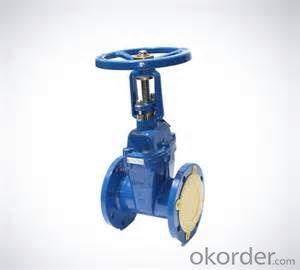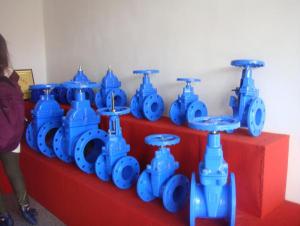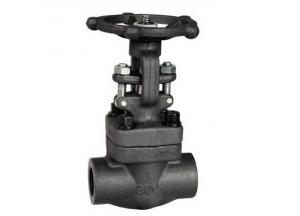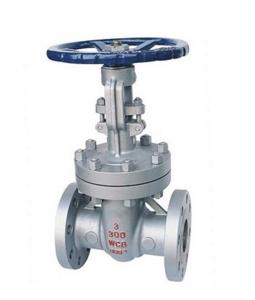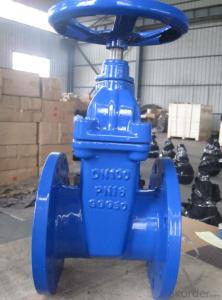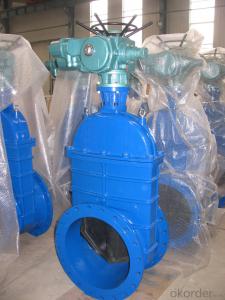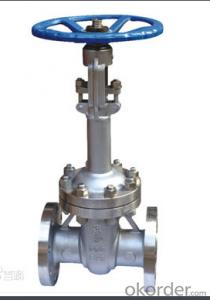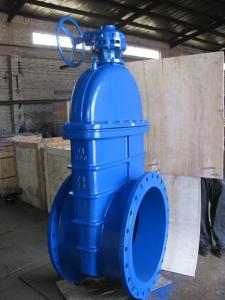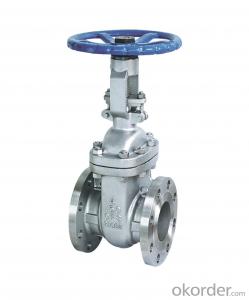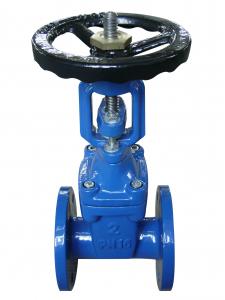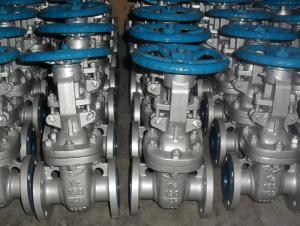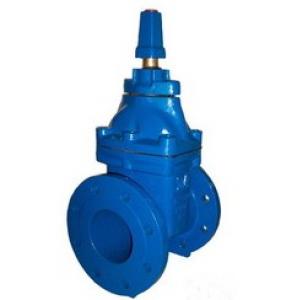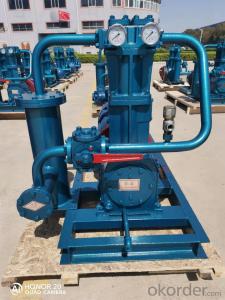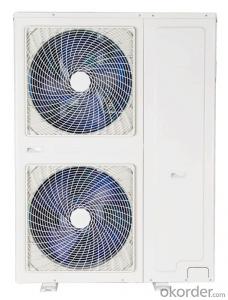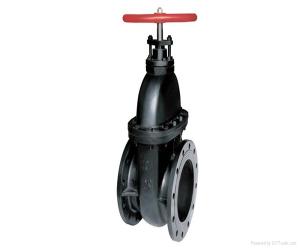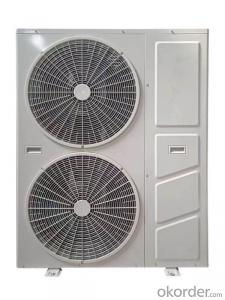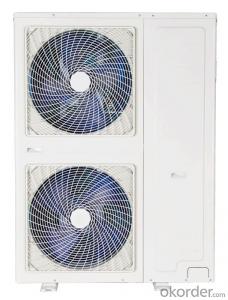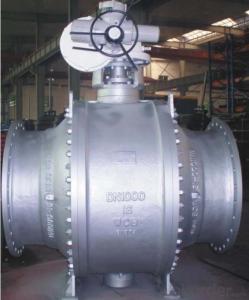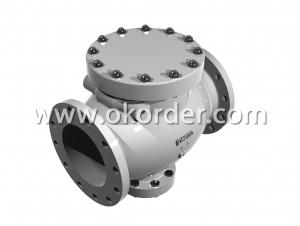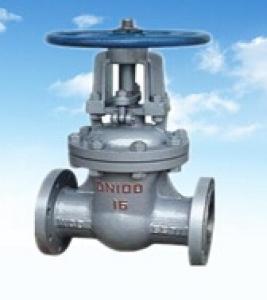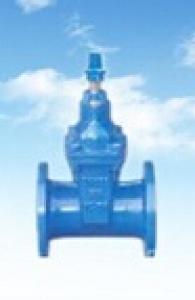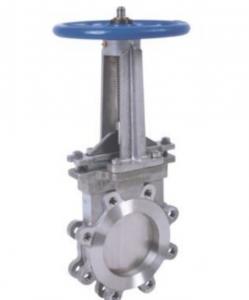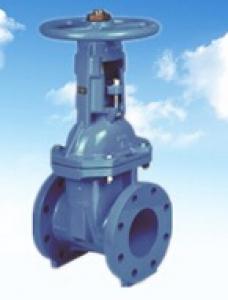Gate Valve BS Resilient Seated gate valve, PN16 Rising Stem
- Loading Port:
- Tianjin
- Payment Terms:
- TT OR LC
- Min Order Qty:
- 200 kg
- Supply Capability:
- 10000 kg/month
OKorder Service Pledge
OKorder Financial Service
You Might Also Like
1.Structure of Gate Valve Description:
A gate valve, also known as a sluice valve, is a valve that opens by lifting a round or rectangular gate/wedge out of the path of the fluid. The distinct feature of a gate valve is the sealing surfaces between the gate and seats are planar, so gate valves are often used when a straight-line flow of fluid and minimum restriction is desired. The gate faces can form a wedge shape or they can be parallel. Gate valves are primarily used to permit or prevent the flow of liquids, but typical gate valves shouldn't be used for regulating flow, unless they are specifically designed for that purpose. Because of their ability to cut through liquids, gate valves are often used in the petroleum industry. For extremely thick fluids, a specialty valve often known as a knife valve is used to cut through the liquid. On opening the gate valve, the flow path is enlarged in a highly nonlinear manner with respect to percent of opening. This means that flow rate does not change evenly with stem travel. Also, a partially open gate disk tends to vibrate from the fluid flow. Most of the flow change occurs near shutoff with a relatively high fluid velocity causing disk and seat wear and eventual leakage if used to regulate flow. Typical gate valves are designed to be fully opened or closed.When fully open, the typical gate valve has no obstruction in the flow path, resulting in very low friction loss.
2. Main Features of the Gate Valve:
• Valve body cavity using non-toxic epoxy resin,both inside and outside flashboard completely is coated with rubber
• Free of water pollution
• High manufacturing accuracy
• High strength
• Environmental protection and energy saving
• Good visual effect
3. Images

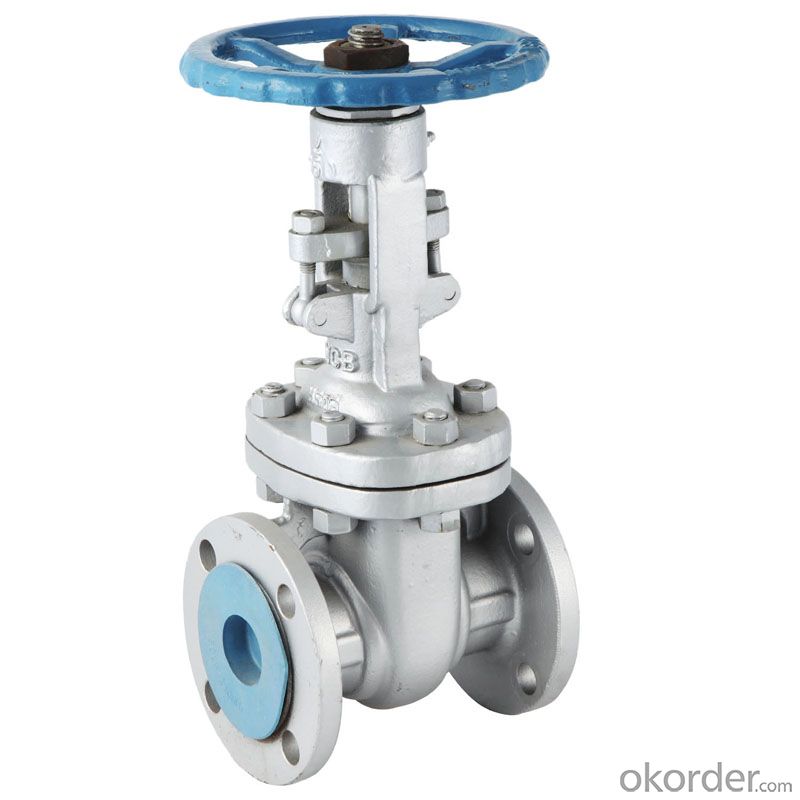
4. Gate valve Specification
1) Size: DN15 - 1, 000mm;
2) Class: PN1.0 - 16.0Mpa;
3) Material: WCB,WCC,WC6,WC9,304,316,CF8,CF3,CF8M,CF3M 4) Standards: API600 API602 API603 API6D
A) Design and manufacture: DIN3352;
B) Face to face dimensions: DIN3202;
C) End flange dimensions: DIN2543-2551;
D) Inspection and test DIN3230.
5.FAQ
1. What's are the characteristics of gate valve?
The distinct feature of a gate valve is the sealing surfaces between the gate and seats are planar, so gate valves are often used when a straight-line flow of fluid and minimum restriction is desired. The gate faces can form a wedge shape or they can be parallel.
2. What is the work principle of gate valve ?
The gate faces can form a wedge shape or they can be parallel. Gate valves are primarily used to permit or prevent the flow of liquids, but typical gate valves shouldn't be used for regulating flow, unless they are specifically designed for that purpose. Because of their ability to cut through liquids, gate valves are often used in the petroleum industry.
3. What is the structure?
Bonnets provide leakproof closure for the valve body. Gate valves may have a screw-in, union, or bolted bonnet. Screw-in bonnet is the simplest, offering a durable, pressure-tight seal. Union bonnet is suitable for applications requiring frequent inspection and cleaning. It also gives the body added strength. Bolted bonnet is used for larger valves and higher pressure applications.
- Q:The difference and use of gate valve and stop valve
- Generally large and nominal caliber DN50 mostly with gate valve, especially industrial high temperature, high pressure, highly toxic and so on.Stop valve is able to stop and adjust flow, small footprint, small size, generally less than the nominal diameter, DN50 occasions use it. Two can be closed, in the flow of linear requirements are not high, you can adjust the flow. Just because of its structural characteristics of the valve to make its flow resistance, so there is a demand for throttling with a little more than the gate valve. In addition, the cut-off valve, whether it is a formal or reverse installed, in the opening and closing process, there is always a very difficult, and therefore can not do a great deal, or it is not easy to open and close. In addition, the cut-off valve has a one-way sealing effect of good features, so in the prevention of reverse flow of the working fluid, it also has a place to play.Hope to be of some help to you!
- Q:What kind of gate valve is Z6CS-H102?
- Z== valve type: gate valve6== pressure rating: 800LB, API602C== structure: bolt connection, valve cover, bolt connection gland, bright rod support typeS== connection form: socket welding, that is, SWH1== body material: A10502== inner material: seat sealing surface STL, gate sealing surface STL, valve stem 13Cr
- Q:How about the model of stainless steel gate valve?
- Stainless steel gate valve is divided into 304 stainless steel gate valve, 316 stainless steel gate valve, 321 stainless steel gate valve. The expression is: Z41H-16P.
- Q:What does gate valve do?
- The gate (gate valve) is a gate opening and closing parts, RAM direction of motion perpendicular to the direction of the fluid, valve can only be fully open and fully closed, can not be adjusted and the throttle.Gate valves for Class150 ~ 2500, the working temperature of -29 to 425 DEG C (Tan Gang) or -29 to 500 DEG C (stainless steel) small caliber pipeline, used to cut off or connect the line of medium, use different materials, can be separately applied to water, steam, oil, nitric acid, acetic acid, oxidizing medium, urea etc. a variety of media, the 3 Classification valve according to the different classification methods can be divided into: the parallel gate valve, wedge gate valve, valve lift, rotating rod valve, quick opening and closing valve, reduced valve, flat gate valve etc.. 4, characteristics of fluid resistance is small, applicable pressure, temperature range, medium flow direction is not restricted, good sealing performance
- Q:What's the difference between open rod gate and dark rod gate valve?
- 3, dark rod valve is located inside of the body, in the process of opening and closing, stem only rotation move, the gate in the valve body lifting; the valve stem rod driven gate valve with the valve stem of the lifting drive thread in the external body, according to the direction of movement of the stem and the position of judge the gate opening and closing and position;
- Q:what are their applicable conditions? Advantages and disadvantages?
- The gate valve is one of the simplest valves. Generally manual, most of the electric valve failure, as a manual. Butterfly valve is more, I saw the pneumatic butterfly valve, that is, with gas control closed, general and solenoid valve matching.Without strict conditions and advantages and disadvantages, of course, the equipment requires a relatively high degree of automatic control. I can check it out on Baidu.
- Q:How to distinguish between gate valve and cut-off valve?
- Standard light valve professionals to answer for you, gate valve refers to the closure of parts (gate) along the central line of the vertical direction of moving valve. The gate valve is mainly used for cutting in the pipeline. The valve is a valve with a very wide, cutting device general caliber DN = 50mm use it, sometimes a small diameter cutting device also use valve, gate valve has the following advantages:Fluid resistance is small.Minor force needed for opening and closing.Medium flow is unrestricted.When opening fully, the sealing surface is eroded by the working medium smaller than the cut-off valve.
- Q:What kind of copper gate valve copper content standards, there are no national standards?
- Please refer to: GB/T12225-2005 "general purpose valve, copper alloy casting technical specification" and GB/T 15116-1994 "die casting copper alloy"
- Q:The main question is, what are the functional differences in which case?
- The gate (gate valve) is a gate opening and closing parts, RAM direction of motion perpendicular to the direction of the fluid, valve can only be fully open and fully closed, can not be adjusted and the throttle gate valve. The direction of motion perpendicular to the direction of the fluid, valve can only be fully open and fully closed, can not be adjusted and the throttle.Gate valve advantages: 1, fluid resistance is small,.2, opening and closing more labor-saving,.3, medium flow unrestricted, not disturbed flow, do not reduce pressure,.4, simple shape, structural length is short, manufacturing process is good, a wide range of applicationsValve shortcomings: 1, between the sealing surface is easy to cause erosion and abrasions, maintenance is more difficult,.2, big size, open need some space, opening and closing time is long,.3, the structure is more complex
- Q:What is the difference between gate valve and gate valve? Is it the same valve?
- The same, very few people call gate valve, all call gate valve.
1. Manufacturer Overview |
|
|---|---|
| Location | |
| Year Established | |
| Annual Output Value | |
| Main Markets | |
| Company Certifications | |
2. Manufacturer Certificates |
|
|---|---|
| a) Certification Name | |
| Range | |
| Reference | |
| Validity Period | |
3. Manufacturer Capability |
|
|---|---|
| a)Trade Capacity | |
| Nearest Port | |
| Export Percentage | |
| No.of Employees in Trade Department | |
| Language Spoken: | |
| b)Factory Information | |
| Factory Size: | |
| No. of Production Lines | |
| Contract Manufacturing | |
| Product Price Range | |
Send your message to us
Gate Valve BS Resilient Seated gate valve, PN16 Rising Stem
- Loading Port:
- Tianjin
- Payment Terms:
- TT OR LC
- Min Order Qty:
- 200 kg
- Supply Capability:
- 10000 kg/month
OKorder Service Pledge
OKorder Financial Service
Similar products
New products
Hot products
Related keywords
